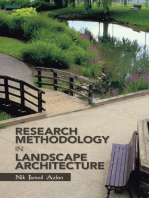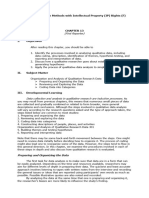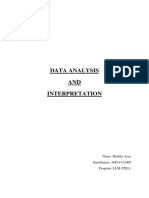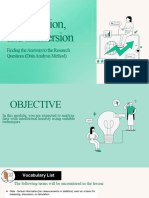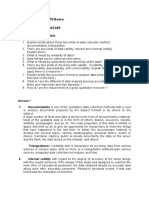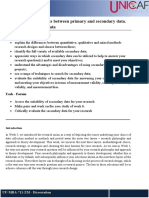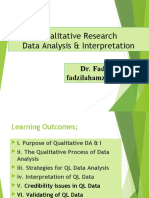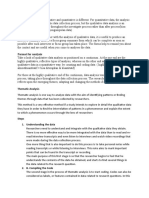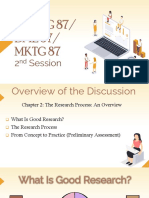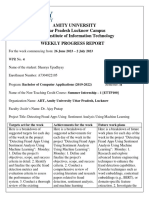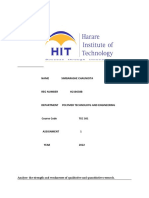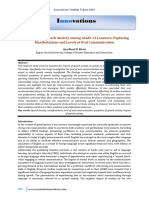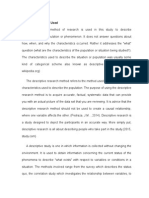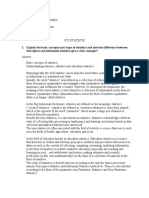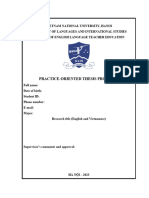Liamputtong 2009
Uploaded by
Cheng Ling YongLiamputtong 2009
Uploaded by
Cheng Ling YongExpert guidance: qualitative methods
Qualitative data analysis: conceptual and
practical considerations
Pranee Liamputtong
Introduction In this paper, I shall discuss the way that qualitative researchers
You have just finished typing the fieldnotes from your final analyse their data. I first discuss salient issues in performing
observation of the study and you proceed to file them. There, qualitative data analysis, and then proceed to discuss and
facing you, is all the material you have diligently collected. suggest different methods of data analysis in qualitative
An empty feeling comes over you as you ask, ‘Now what do research. I also provide some discussion on the use of
I do?’ (pp. 172-173).1 computer-assisted data analysis. Note that I have excluded
discussion on content analysis method in this paper because
The above quote reflects the response that many qualitative
content analysis makes use of simple statistical analysis, which
researchers, new and experienced, have when faced with a
is not the focus of this paper.
large amount of collected data that must now be organised in
a meaningful way,2 in processes referred to as data analysis.
Qualitative data analysis: when to begin
The idea of data analysis signifies transformation. Through
analytic processes the researchers turn the data, which is Qualitative data analysis should commence from the
often voluminous, into “a clear, understandable, insightful, beginning of research. Researchers immerse themselves in
trustworthy and even original analysis” (p. 1). 3 There are their fieldwork (be it an interview, participant observation, or
different approaches that qualitative researchers can use published text) and then in reading, and rereading, the data,
to make sense of their data. Most common ones include they make sense of the data they have generated. Through
thematic analysis, narrative analysis, discourse analysis, immersion in the data, researchers attempt to understand
and semiotic analysis.4,5 The main aim of each approach is what they have obtained.4
to “understand the subject at hand” (p. 545).4 All of these By commencing data analysis early, researchers move back
approaches have played a significant part in the qualitative and forth between the data they have gathered and their
research tradition.6 strategies to collect new (and often better) data. As Miles and
Huberman7 suggest, this movement back and forth “can be
Acknowledgement a healthy corrective for built-in blind spots. It makes analysis
This paper is an abridged version of a chapter in an ongoing, lively enterprise that contributes to the energising
Qualitative Research Methods by Pranee Liamputtong, process of fieldwork” (p. 50). Many other qualitative
Third edition. researchers advise interweaving data collection and analysis
Oxford University Press, Melbourne. from the beginning.3,4,8-11 I contend that we need to treat data
analysis as part of the research design, the literature review, the
Abstract
Qualitative inquiry requires that collected data is organised in a meaningful way, and this is referred to as data
analysis. Through analytic processes, researchers turn what can be voluminous data into understandable and insightful
analysis. This paper sets out the different approaches that qualitative researchers can use to make sense of their
data including thematic analysis, narrative analysis, discourse analysis and semiotic analysis and discusses the ways
that qualitative researchers can analyse their data. I first discuss salient issues in performing qualitative data analysis,
and then proceed to provide some suggestions on different methods of data analysis in qualitative research. Finally,
I provide some discussion on the use of computer-assisted data analysis.
Health Promotion Journal of Australia 2009; 20:133-9
Health Promotion Journal of Australia 2009: 20 (2) 133
Liamputtong Article
formation of theory, the data collection, the ordering of data, of codes, and some of them may seem very descriptive and
and the writing process. All these issues will have significant repetitive. The researchers may attempt to abandon certain
ramifications of how we undertake our data analysis. codes as they believe that those codes are irrelevant or
repetitive. I suggest that the researchers must be patient with
Coding in qualitative data analysis this seeming surfeit of codes because they may be essential
Coding is the beginning point for most forms of qualitative for the construction of theory. The codes we develop at the
data analysis.11,12 Coding, according to Charmaz,13 refers to beginning will change as we delve into more data.
the process whereby researchers define what the data are When I carry out my data analysis, I follow most of the advice
about, and it is the first step in data analysis. In carrying out that I have given above. I normally stick closely to the data. I
coding for each piece of data, the researchers name chunks often name the codes using the descriptions that I see in the
of data with a label or a name. This is referred to as a code. data. I tend to use short names for my codes. Occasionally,
Often, a code in qualitative research is presented as a word I may use some fancy names or metaphors to represent my
or short phrase that “symbolically assigns a summative, salient, codes. And at some points, I may also use what Charmaz13
essence-capturing, and/or evocative attribute for a portion of and Saldaña12 call ‘in vivo’ codes; terms or names that the
language-based data” (p. 3).12 As such, coding is the first step participants actually use in their narratives. In vivo codes allow
for the researchers to move beyond tangible data to make researchers to maintain the meanings of the participants’
analytic interpretations.11,12,14,15 views and actions in their coding process.13 So the codes I
Table 1 provides a list of basic questions is recommended use depend on the data that I have.
by Flick16 for qualitative researchers to use as their coding
strategies. Flick suggests that the researchers should examine Coding: steps and strategies
the text regularly and repeatedly with these questions, and I wish to present the strategies that are provided by Bryman8
from them, the researchers will be able to disclose the text. (pp. 550-552) in this section, which I believe are useful for
Although researchers may have these types of questions in many qualitative researchers. It is crucial that the researchers
mind, Saldaña12 suggests that we should consciously ask commence coding as soon as possible. Similar to the practice
ourselves the following question when reading through the of grounded theory research,5,13 it is wise to start coding
data: What strikes me? This question often offers to the while data are still being collected. This will permit the
researchers to some “surprising, unusual, or conceptually researchers to have a better understanding of their data,
interesting” results (p. 153).17 to follow up ambiguous data and help with theoretical
sampling. Additionally, it may reduce the feeling of being
Often, new and experienced researchers feel unskilled or
overwhelmed with too much data, which usually happens
clumsy at the beginning of the coding process10,14,18 and may
when the researchers commence data analysis after all the
not feel confident about looking for meanings and naming
data are collected.
the codes. However, confidence will gradually increase with
continued efforts at data analysis. At the beginning of the First, the researchers must read through the initial set of
coding stage, the researchers may find that they have a lot transcripts, field notes, or documents without making any
notes, or attempting to interpret the data. After reading
Table 1: Basic questions used for coding strategies. through the data, they may wish to write down a few notes
Questions What to look for? about what appears to be particularly interesting, important,
What? What is the concern here? Which course of or significant. Then, they must read through the data again.
events is mentioned? However, this time, they should commence making marginal
Who? Who are the persons involved? What roles do
they have? How do they interact?
notes about significant categories that emerge from the data.
How? Which aspects of the event are mentioned (or At this stage, the researchers should try to make as many notes
omitted)? as possible. Initially, the notes may be very basic, and the
When? How long? Where? Referring to time, course and ___location: When
researchers may use key words expressed by the participants
does it happen? How long does it take? Where
did the incident occur? or to give names to themes in the data. This is what I mean
Why? Which reasons are provided or can be by coding.
constructed?
At this point, it may be useful to generate an index of terms or
What for? What is the intention here? What is the purpose?
By which? Referring to means, tactics, and strategies names that may help the researchers to interpret and theorise
for achieving the aim: What is the main tactic the data. The researchers then review the codes. If they have
here? How are things accomplished? two or more words or phrases that relate to the same issue,
delete one of them. They must then examine closely to see if
134 Health Promotion Journal of Australia 2009: 20 (2)
Expert guidance: qualitative methods Qualitative data analysis
the developed codes are relevant to concepts and categories Thematic analysis is referred to as “a method for identifying,
in the existing literature. They must try to see if there are any analysing and reporting patterns (themes) within the data”
connections between the codes or if there is evidence that (p. 79).19 The techniques used for analysing data in thematic
may suggest one thing tends to be associated with or caused by analysis and grounded theory are broadly similar with the main
something else. Then, the researchers should start to consider difference being that grounded theory includes theoretical
more general theoretical understandings in relation to the sampling,13,21 whereas thematic analysis does not.
codes and data. By the time that they reach this point, they There are two main steps in doing thematic analysis. Firstly,
should be able to construct some general theoretical notions or read through each transcript and try to make sense of the
concepts about their data. Attempting to outline connections interview data. Then, as part of a collective set, the researchers
between concepts and categories that they are generating is a need to examine the transcript and make sense of what is
good strategy to employ at this time. Additionally, they should being said by the participants as a group.22 Thematic analysis
try to see how these tentative concepts and linkages relate to “involves searching across a data set – be that a number
the existing literature. of interviews or focus groups, or a range of texts – to find
Practical tips: repeated patterns of meaning” (p. 86).19 Coding plays a
• In the early stages of data analysis, do not worry about major part in thematic analysis, and as in grounded theory,
generating too many codes. You will soon find out researchers need to perform initial and axial coding in order to
that some codes will be useful, but others will not. It is deconstruct data, put them into codes and find links between
important to be a bit inventive and imaginative at the them).11-12 Axial coding is the step that allows researchers to
beginning and tidy up later on. connect different codes identified in the initial coding into
categories and sub-categories.22 By making connections
• Recognise too that any piece of data can be coded in more
between main categories and sub-categories, researchers can
than one way. Hence, you may want to play with the data
find themes in their data.
and look closely to see if they can code data differently.
This can be exciting. Braun and Clarke19 (p. 87) provide some steps that I believe
are useful for readers to adopt. First, researchers should
• Codes emerge as the researchers delve into their data
make themselves familiar with their data. This means that
and look for meanings within it. This active coding allows
researchers should transcribe the data themselves. They
researchers to repeatedly interact with their data and
then need to read and reread the data, and write down their
permits researchers to ask many different questions about
initial ideas about the data. Next, initial codes need to be
their data. As a consequence, coding may take researchers
generated by researchers looking for themes and collating
into “unforeseen areas and new research questions” (p.
codes into tentative themes. At this stage, gather all data that
46).13
is related to each potential theme, then revise the themes
Writing marginal notes on the data or transcripts will allow
initially developed. Now check if the themes work in relation
researchers to maintain their attention to detail, and assist
to the codes extracted across the entire data set. Next, gather
colleagues or other researchers to see how the researchers
a thematic ‘map’ of the analysis, and then define and name
have coded their transcripts. Later on, marginal notes are used
the themes. It is also important to carry out an ongoing analysis
in the coding cycle. As you read through the transcripts again
to refine the themes so that clear definitions and names for
and again, new codes may be added and this can be easily
each theme can be generated.
done using marginal notes, which can gradually be refined
into codes.8,12,17 Narrative analysis
In narrative analysis, the participants’ stories (narratives) are
Different types of qualitative data analysis
analysed, and then re-storied (retold) into a framework that
Different types of data analysis are commonly employed in
will make sense to readers.3,17 In the process of re-storying,
qualitative research. Each type of data analysis is suitable for
stories are examined for key elements such as time, place,
different types of questions asked. Researchers must decide
plot and scene. The stories that people tell do not necessarily
which one will be more appropriate for their research.
appear in a chronological order3 so they are then rewritten by
Researchers often combine several data analysis strategies
placing them within a chronological order.23 This chronology,
in one study.
with its focus on sequence, differentiates narrative analysis
from other types of data analysis. However, researchers need
Thematic analysis to provide a causal link among ideas during the re-storying
A common type of analysis in qualitative research is thematic process.
analysis; sometimes called interpretive thematic analysis.19,20
Health Promotion Journal of Australia 2009: 20 (2) 135
Liamputtong Article
Within the framework of chronology, stories will have a marriage, parenthood, career change and retirement. Begin
beginning, a middle and an end.3 A chronology may comprise to connect the thematic ideas developed about the narrative
past, present, and future ideas.24 Stories may also include within the broader literature and theories, and then carry out
elements that typically appear in novels including time, place case-by-case comparisons. Although there may be several life
and scene. As in good novels, other elements such as struggle histories in their research, some case-by-case comparison can
(conflict, hardship), a lead actor (main character) and some be revealing. They may, for example, compare how different
causality sequences may also be included. The story-line may individuals experience similar transitions in their lives, or the
also include the three-dimensional narrative inquiry space that views of different participants on the event in which they are
Clandinin and Connelly24 have developed. These include: all involved.
the personal and social (indicating the interaction); the past,
present and future (referring to continuity); and the place Discourse analysis
(meaning situation). Information about the setting or context Social reality, according to Phillips and Hardy,25 is produced
of the participants’ experiences may also be included in the through discourses. Hence, we cannot fully understand social
storyline. Beyond the chronology, the researchers may look interactions without making connections to the discourses that
for themes that emerge from the story in order to construct give meaning to them. The task of discourse analysis is then to
the meaning of the story. Therefore, narrative analysis may examine the connection between reality and discourse.
include both the story and emerging themes.
Discourse analysis has different meanings and practices
Gibbs3 (pp. 63-64) suggests the following practical steps for in different disciplines.25-27 There are many ways of doing
doing narrative analysis. The researchers must familiarise discourse analysis, and different theoretical perspectives
themselves with the content and structure of the narratives by in discourse analysis such as critical discourse analysis,
reading and re-reading the transcript closely. They should look Foucauldian discourse analysis, and interactional discourse
for some crucial aspects of the narratives, for example: events analysis.6,25,26,28,29 However, the central argument shared by all
– what has happened?; experiences – including feelings, is a refusal to accept that “language is simply a neutral means
images, meanings and reactions; accounts, explanations, of reflecting or describing the world”; rather all advocate
excuses, which are given in the narratives, and; narrative “the central importance of discourse in constructing social
form, including the linguistic and metaphorical form of life” (p. 172).26
telling the stories, which may include how the narrator and
Discourse analysts will ask different questions from
the researcher interact, characters, emplotment, metaphor,
conventional social scientific questions. For a study about
and chronological sequencing. Then, they need to write a
why women decline prenatal screening and diagnostic tests,
short summary about key elements such as the beginning,
for example, discourse analysts will not try to answer the
the middle and the end of the story, and take note of some
reasons why women refuse to do so, but seek to find out
thematic ideas and structural points on the right margin of the
how the women’s decisions for refusal are made, how they
transcript. They need to look for transitions between themes.
respond to criticism of others about their decisions, and how
They may examine texts on different kinds of transitions
they re-establish their self-identity as non-compliant mothers.
such as the move from a family life to becoming a single
From careful reading of the data or texts and asking these
mother, and identify texts expressive of specific themes that
alternative questions, discourses about conflicting ideologies
are used at particular stages of the biography; for example,
of motherhood amid the medicalisation of childbirth and living
is intimate relationship only mentioned at certain stages of
in a risk society may surface as the reasons for the refusal by
the participant’s life history? They may make some notes
these women.30
about the thematic ideas that they have developed from
Discourse analysis attempts to uncover “how the socially
the transcript, and then use them to indicate where the
produced ideas and objects that populate the world were
participant provides accounts for his or her actions and to
created in the first place and how they are maintained and
exhibit the general structure of the story. They should also
held in place over time” (p. 6).25 It aims to reveal the means
look for any interruptions/discontinuities that may contradict
in which social realities are produced. The most important
the themes and use pen or pencil to exhibit any mini-stories
contribution of discourse analysis is then to “examine how
or sub-plots that may be located in the transcript. They may
language constructs phenomena, not how it reflects and reveals
use arrows to mark the links between components, identify
it”. However, it is important to note too that researchers who
emotive language, imagery, metaphors and passages that may
adopt discourse analysis tend not to claim that their way “is
indicate the feelings expressed by the participant, and then
the only way of reading a text” (p. 188).26 Rather, they will
code thematic ideas and develop a coding frame. At this
argue that “a discourse analysis is an interpretation, warranted
stage of data analysis, use some broad themes like childhood,
136 Health Promotion Journal of Australia 2009: 20 (2)
Expert guidance: qualitative methods Qualitative data analysis
by detailed argument and attention to the material being constructed out of an isolated text, but in relation to each
studied” (p. 188). other.32
Gill26 (pp.178-89) provides some steps in using discourse Grbich29 (pp. 177-178) suggests a few steps I find very useful
analysis, as follows. First, the researchers construct their initial and readers may wish to follow. The researchers need to adopt
research questions. They then choose the data or texts to be a “critical and skeptical reading” standpoint, and remind
analysed. This may mean that data may have to be collected themselves that they will not accept nothing and reject nothing
and transcribed. A transcript has to be recorded verbatim with in the first place. They must remember that the outcome of
as many features of the talk included as possible. It should semiotic analysis is “the production of an understanding of
not be cleaned up or corrected in anyway and it must not the text’s structure, its content and its omissions”. In reading
be a summary. They must read and interrogate the data/text. through the text, perform the following tasks:
This involves interrogating the researchers’ own assumptions • permit the texts to argue against or challenge each
and the ways they make sense of realities. A great deal of other;
‘scepticism’ should be used in interrogating the data/text.
• look for contradictions and inconsistencies of ideas,
Code the data/text as inclusively as possible, and then revise
expressions, and metaphors;
research questions as patterns in the data/text emerge. Analyse
• identify any generalisations in the text and use them to
the data/text by examining regularity and variability in the
demolish any principles that were used;
data, formulate tentative hypothesis, and check reliability and
validity through deviant case analysis, analysis of coherence, • argue against any argument that was made; search for and
and participants’ understanding (if the data is from face-to- unravel or simplify “the complexities of all dichotomies,
face conversations). Finally, write up the analysis. binary oppositions and hierarchies”;
• attempt to read against the essence of the text in order
Semiotic analysis to find other ways for reading the text; and explore links
Semiotics is “the study of signs, sign systems and their with other texts, and;
meanings” (p. 170). 29 According to Bryman 8 (p. 275), • search for the margins and pinpoint marginalised voices
semiotics places particular importance on exploring the and hidden information.
“deeper meaning” of the data. A semiotics approach attempts When writing up analysis, try to allow as many interpretations
to reveal the processes of making meaning and “how signs as possible; try not to make any concrete statements; stay close
are designed to have an effect upon actual and prospective to the language used in the text; and display their ambiguity
consumers of those signs”. Semiotics is suitable for analysing and ambivalence. Remember you are not creating a finite text.
signs in our everyday life. Hence, it can be applied in not It is only a transitional finding, so resist closure.
only documentary data analysis, but also to other data types
Semiotic researchers would argue that there are many insights
primarily because of its “commitment to treating phenomena
that we may use and gain in the practice of semiotic analysis.
as texts”.
Daly and colleagues31 (p. 178) warn us that this approach
Semiotic analysis goes further than simply analysing the indeed “conveys complexity, and mystery at the same time
themes as in thematic analysis.31 It attempts to uncover the as sending the ‘beware-of-the-dog’ message – in other words,
way meaning is formed through “a process of signification enter at your own risk”. This is because we may be accused of
or connotation” (p. 293).32 The aim of semiotic analysis is to being a non-scientific researcher totally immersed in our own
find any themes that have been “omitted or repressed and/ indulgent world. However, we must remember that semiotic
or overlayed by other themes” (p. 43).33 Semiotics requires analysis aims at exploring alternative ways of interpretation.
the researchers to ask more questions to deepen the data
analysis. Computer-Assisted Qualitative Data Analysis
To put it simply, semiotics “is concerned to uncover the (CAQDAS)
hidden meanings that reside in texts” (p. 531).8 It invites Nowadays, there are computer-assisted programs that will
the researchers to attempt to “see beyond and beneath the assist or facilitate qualitative researchers with data analysis. I
apparent ordinariness of everyday life and its manifestation” use the words ‘assist’ and ‘facilitate’ here to remind readers
(p. 532).8 When reading texts, researchers must bear in that computer packages are unable to analyse the data for
mind that texts may have implicit meanings. In order to do researchers; they help the researchers to find, categorise and
this, researchers must adopt some theoretical frameworks retrieve data/texts faster than using a manual search.3,8,22,34-36
to deconstruct a text and the process of deconstruction Often, those who are not familiar with qualitative data analysis
must occur in a contextualised way.31 Meaning cannot be will say that they use computer packages such as NVivo to
Health Promotion Journal of Australia 2009: 20 (2) 137
Liamputtong Article
analyse their data. This appears to be a misunderstanding into chunks that are then retrieved and grouped into related
and I warn you not to say any thing like this, as reviewers fragments.8,37 CAQDAS then may not be suitable for certain
will know that you lack knowledge about data analysis in types of qualitative data. From their experience, Catterall and
qualitative research. Maclaran39 argue that computer programs are not appropriate
Most of the well-known programs are based on the code-and- for focus group data because the code and retrieve function
retrieve theme.22 They permit researchers to code texts while results in a loss of the communication and interaction process
working at the computer and to retrieve the coded text. This that is essential in the focus group method. Some qualitative
means that the computer does all the manual tasks associated researchers40-43 argue that the coding and retrieval features can
with the coding process that I provided earlier. More recently be done through powerful word-processing software, such as
some programs have tried to provide the researchers with Word for Windows (through the Find function) that requires
analytic procedures, and different facilities to help researchers a lengthy period of becoming familiar with the operations of
examine features and relationships in the texts. Often, they that program.
are referred to as theory builders. However, it does not mean Many students and researchers have raised the question of
that they can build theory on their own. Rather, they have whether they should use CAQDAS with data analysis. Bryman8
various tools that help the researchers to make comparisons (p. 567) advises students and researchers that if they have a
and develop some theoretical ideas. small number of cases in their research, it may not be worth
There are several computer packages that qualitative the time and trouble of learning to master new software. It may
researchers have used. Three CAQDAS with common features also be too expensive for personal purchase, but if you have
include ATLAS.ti (now in version 5), MAXQDA (now in version free access to the software, you may like to take the time to
2) and NVivo (now in version 8).3,12 Their features include: the learn. Learning new software provides students and researchers
transfer and display of rich texts; the construct of code lists as with useful skills that they can make use of in the future. Many
a hierarchy; permitting the researchers to retrieve texts which of my postgraduate students do take this position.
have been coded; allowing the examination of coded texts in Personally, I believe strongly that computers can be very
the context of the original data; and permitting the writing of useful as adjuncts to qualitative research. CAQDAS can
memos, which can be linked to codes and data. provide efficiencies in the data analysis process. However,
Although CAQDAS are useful for many researchers, there computer programs are not always required, nor do they
are many criticisms about their use. Fielding and Lee37 and solve many of the central problems of qualitative research.
Gibbs3 argue that there is a sense of being distant from the I remain more ambivalent about the role of technology in
data when using CAQDAS. Those who use paper-based helping qualitative researchers analyse their data, as I do
analysis would argue that they are closer to the words of their not believe that computer packages can properly do this for
participants. This may be because the early programs did not us.10,41,44 I personally do not use any computer-package for
make it easy for researchers to move back and forth between data analysis. I work closely with my data by using colour
the data to examine the context of coded or retrieved text, pens (and highlighters) and word-processing to cut and paste
but recent programs have allowed this to happen. However, the data.
many researchers still wish to be closer to their data and hence
CAQDAS will limit that closeness. Conclusion
CAQDAS do not, and cannot, assist with decisions about There are many ways that qualitative researchers can make
the coding or about the interpretation of findings. We are sense of their data. Each approach offers different ways of
warned by Minichiello and colleagues22 (p. 252) that “the seeing the data and different ways for the researchers to
computer does not replace the analytical thinking processes interpret the findings they generate. I have suggested several
underpinning ‘interpretive’ research”. Computer programs ways for making sense of the data in the paper. I hope that
cannot “develop propositions from the data”, nor tell the by now, readers would have some basic ideas of how they
researchers that there are different theories that they can can analyse their data.
apply. Any theoretical framework has to be introduced by Data analysis is a craft (Miles & Huberman 1994).7 It requires
the researchers themselves. some skills and experience. As in any craft, the more we
The code-and-retrieve process of computer programs may practise our data analysis, the more skillful we will become.
result in a fragmentation of the textual materials.38 Hence, the At the beginning, all qualitative researchers feel overwhelmed
narrative flow of the data may be lost.8 Context is crucial in with the data and ambivalent about the task of data analysis.
qualitative research. The de-contexualisation of the data may But through experience and practice, data analysis will
also occur due to the fragmentation process of coding text become easier.
138 Health Promotion Journal of Australia 2009: 20 (2)
Expert guidance: qualitative methods Qualitative data analysis
References 24. Clandinin DJ, Connelly M. Narrative Inquiry: Experience and Story in Qualitative
Research. San Francisco(CA): Jossey-Bass; 2000.
1. Bogdan RC, Biklen SK. Qualitative Research for Education: An Introduction to
25. Phillips N, Hardy C. Discourse Analysis: Investigating Processes of Social
Theories and Methods. 5th ed. Boston (MA): Pearson Education; 2007.
Construction. Thousand Oaks (CA): Sage Publications; 2002.
2. Rubin HJ, Rubin IS. Qualitative Interviewing: The Art of Hearing Data. 2nd ed.
26. Gill R. Discourse analysis. In: Bauer MW, Gaskell G, editors. Qualitative
Thousand Oaks (CA): Sage Publications; 2005.
Researching with Text, Image and Sound. London (UK): Sage Publications; 2000.
3. Gibbs GR. Analyzing Qualitative Data. London (UK): Sage Publications; p. 172-190.
2007.
27. Rapley T. Doing Conversation, Discourse and Document Analysis. London (UK):
4. Green J, Willis K, Hughes E, Small R, Welch N, Gibbs L, et al. Generating best Sage Publications; 2007.
evidence from qualitative research: The role of data analysis. Aust N Z J Public
28. Willig C. Introducing Qualitative Research in Psychology—Adventures in Theory
Health. 2007;31(6):545-50.
and Method. Buckinghamshire (UK): Open University; 2003.
5. Liamputtong P. Qualitative Research Methods. 3rd ed. Melbourne (AUST):
29. Grbich C. Qualitative Data Analysis: An Introduction. London (UK): Sage
Oxford University Press; 2009.
Publications; 2007.
6. Marvasti AB. Qualitative Research in Sociology. London (UK): Sage Publications;
30. Liamputtong P, Halliday J, Warren R, Watson L, Bell R. Why do women decline
2004.
prenatal screening and diagnosis?: Australian women’s perspective. Women &
7. Miles MB, Huberman AM. Qualitative Data Analysis. 2nd ed. Thousand Oaks Health. 2003;37(2):89-108.
(CA): Sage Publications; 1994.
31. Daly J, Kellehear A, Glicksman M. The Public Health Researcher: A Methodological
8. Bryman A. Social Research Methods. 3rd ed. Oxford (UK): Oxford University Guide. Melbourne (AUST): Oxford University Press; 1997.
Press; 2008.
32. Hesse-Biber SN, Leavy LP. The Practice of Qualitative Research. Thousand Oaks
9. Carpenter C, Suto M. Qualitative Research for Occupational and Physical (CA): Sage Publications; 2005.
Therapists: A Practical Guide. Oxford (UK): Blackwell Publishing; 2008.
33. Kellehear A. The Unobtrusive Researcher: A Guide to Methods. Sydney (AUST):
10. Schiellerup P. Stop making sense: The trials and tribulations of qualitative data Allen & Unwin; 1993.
analysis. Area. 2008;40(2):163–71.
34. Bazeley P. Qualitative Data Analysis with NVivo. London (UK): Sage Publications;
11. Boeije HR. Analysis in Qualitative Research. London (UK): Sage Publications; 2007.
2009.
35. Lewins A, Silver C. Using Software in Qualitative Research: A Step-by-step Guide.
12. Saldaña J. The Coding Manual for Qualitative Researchers. London (UK): Sage London (AUST): Sage Publications; 2007.
Publications; 2009.
36. Richards L, Morse JM. Readme First for A User’s Guide to Qualitative Methods.
13. Charmaz K. Constructing Grounded Theory: A Practical Guide through Qualitative 2nd ed. Thousand Oaks (CA): Sage Publications; 2007.
Analysis. London (UK): Sage Publications; 2006.
37. Fielding NG, Lee RM. Computer Analysis and Qualitative Research. Thousand
14. Holton JA. The coding process and its challenges. In: Bryant A, Charmaz K, Oaks (CA): Sage Publications; 1998.
eidotrs. The Sage Handbook of Grounded Theory. Thousand Oaks (CA): Sage
38. Weaver A, Atkinson P. Microcomputing and Qualitative Data Analysis. Avebury
Publications; 2007. p. 265-90.
(UK): Akdershot; 1995.
15. Corbin J, Strauss A. Basics of Qualitative Research: Techniques and Procedures for
39. Catterall M, Maclaran P. Focus group data and qualitative analysis programs:
Developing Grounded Theory. 3rd ed. Thousand Oaks (CA): Sage Publications;
Coding the moving picture as well as snapshots. Soc Res Online [serial on the
2008.
Internet]. 1997 [cited 2009 Apr 6]; 2(1):[about 12 p.]. Available from: http://
16. Flick U. An Introduction to Qualitative Research. 3rd ed. London (UK): Sage www.socresonline.org.uk/2/1/6.html
Publications; 2006.
40. Stanley L, Temple B. Doing the business? Evaluationg software packages to aid
17. Creswell JW Qualitative Inquiry and Research Design: Choosing among Five the analysis of qualitative data sets. In: Burgess RG, editor. Studies in Qualitative
Approaches. 2nd ed. Thousand Oaks (CA): Sage Publications; 2007. Methodology: Computing and Qualitative Research. Greenwich (UK): JAI Press;
18. Li S, Seale C. Learning to do qualitative analysis: An observational study of 1995. 169–97.
doctoral work. Qual Health Res. 2007;17(10):1442-52. 41. La Pelle N. Simplifying qualitative data analysis using general purposes software
19. Braun V, Clarke V. Using thematic analysis in psychology. Qualitative Research tools. Field Methods. 2004;16(1):85-108.
in Psychology. 2006;3:77-101. 42. Ryan GW. Using a word processor to tag and retrieve blocks of text. Field
20. Markovic M. Analyzing qualitative data: Health care experiences of women Methods. 2004;16(1):109-30.
with gynecological cancer. Field Methods. 2006;18(4):413-29. 43. Hahn C. Doing Qualitative Research using Your Computer: A Practical Guide.
21. Morse J. Ethics in action: Ethical principles for doing qualitative health research. London (UK): Sage Publications; 2008.
Qual Health Res. 2007;17(8):1003-5. 44. Stroh M. Computers and qualitative data analysis: To use or not to use . . . ?
22. Minichiello V, Aroni R, Hays T. In-depth Interviewing: Principles, Techniques, In: Burton D, editor. Research Training for Social Scientists. London (UK): Sage
Analysis. 3rd ed. Sydney (AUST): Pearson Education; 2008. Publications; 2000. p. 226–43.
23. Ollerenshaw JA, Creswell JW. Narrative research: A comparison of two restorying
data analysis approaches. Qualitative Inquiry. 2002;8(3):329-47.
Author
Pranee Liamputtong, Personal Chair in Public Health, School of Public Health, La Trobe University, Bundoora, Victoria
Correspondence
Pranee Liamputtong, School of Public Health, La Trobe University, Bundoora, Victoria, Australia 3086. Fax: (03) 94791783; e-mail:
[email protected]
Health Promotion Journal of Australia 2009: 20 (2) 139
You might also like
- Research Methods: Simple, Short, And Straightforward Way Of Learning Methods Of ResearchFrom EverandResearch Methods: Simple, Short, And Straightforward Way Of Learning Methods Of Research4/5 (13)
- Finding The Answers To The Research Questions Lesson 1-Data Analysis MethodNo ratings yetFinding The Answers To The Research Questions Lesson 1-Data Analysis Method4 pages
- Inquiries, Investigation, and Immersion: Quarter 2 Module 1-Lesson 1100% (2)Inquiries, Investigation, and Immersion: Quarter 2 Module 1-Lesson 114 pages
- Prepare and Organize Your Data. This May Mean Transcribing Interviews orNo ratings yetPrepare and Organize Your Data. This May Mean Transcribing Interviews or4 pages
- (Emerson) Data analysis and interpretationNo ratings yet(Emerson) Data analysis and interpretation7 pages
- Implementing-different-analysis-approaches-with-ATLAStiNo ratings yetImplementing-different-analysis-approaches-with-ATLASti16 pages
- qualitativedataanalysis-class-20112016-161201130314No ratings yetqualitativedataanalysis-class-20112016-16120113031430 pages
- Qualitative Data Analysis: I. Qualitative Data (Thorne, S. RN, PHD, N.D.)No ratings yetQualitative Data Analysis: I. Qualitative Data (Thorne, S. RN, PHD, N.D.)3 pages
- Inquiries, Investigation, and Immersion: Finding The Answers To The Research Questions (Data Analysis Method)No ratings yetInquiries, Investigation, and Immersion: Finding The Answers To The Research Questions (Data Analysis Method)15 pages
- Research Design: Planning The Research: Chapter ObjectivesNo ratings yetResearch Design: Planning The Research: Chapter Objectives52 pages
- Qualitative Research: Distinctions From Quantitative ResearchNo ratings yetQualitative Research: Distinctions From Quantitative Research6 pages
- Designing Reseorch Qualitative Procedures: Questi0118 FroidNo ratings yetDesigning Reseorch Qualitative Procedures: Questi0118 Froid12 pages
- Qualitative Data Analysis InterpretationNo ratings yetQualitative Data Analysis Interpretation29 pages
- Dissertation Methodology Structure Secondary Data100% (1)Dissertation Methodology Structure Secondary Data4 pages
- Reflection 9-Communicating The Research Results: Research Presentation Abulencia, Jessa Mae PNo ratings yetReflection 9-Communicating The Research Results: Research Presentation Abulencia, Jessa Mae P6 pages
- Qualitative Research for Beginners: From Theory to PracticeFrom EverandQualitative Research for Beginners: From Theory to Practice3/5 (2)
- Chapter 2 The Research Process-An OverviewNo ratings yetChapter 2 The Research Process-An Overview12 pages
- Biodegradability Rate of Oxo-Biodegradable Plastics Using Cow, Goat, and Pig ManureNo ratings yetBiodegradability Rate of Oxo-Biodegradable Plastics Using Cow, Goat, and Pig Manure10 pages
- The Critiques and Criticisms of Positive Psychology A Systematic ReviewNo ratings yetThe Critiques and Criticisms of Positive Psychology A Systematic Review31 pages
- Psychological Safety in High-Performance TeamsNo ratings yetPsychological Safety in High-Performance Teams8 pages
- Pengembangan Alat Peraga Pada Materi Energi Listrik Di SD Negeri 11 Danau Kandung SuliNo ratings yetPengembangan Alat Peraga Pada Materi Energi Listrik Di SD Negeri 11 Danau Kandung Suli10 pages
- PDF Research Methods for Leisure and Tourism 5th edition Edition Anthony James Veal download100% (1)PDF Research Methods for Leisure and Tourism 5th edition Edition Anthony James Veal download57 pages
- Understanding Speech Anxiety Among GradeNo ratings yetUnderstanding Speech Anxiety Among Grade9 pages
- Proposed Research Titles and SOP Eric-P.-tamang-1No ratings yetProposed Research Titles and SOP Eric-P.-tamang-18 pages
- Explain The Basic Concepts and Scope of Statistics and State The Difference Between Descriptive and Inferential Statistics Give A Clear Example?No ratings yetExplain The Basic Concepts and Scope of Statistics and State The Difference Between Descriptive and Inferential Statistics Give A Clear Example?9 pages



